Electronic Braille Writers
Listen to the post:
Mountbatten Brailler
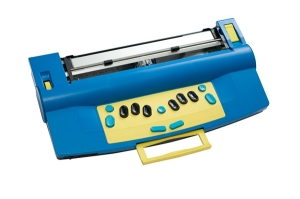
This picture shows a Mountbatten Brailler.
The Mountbatten Brailler is an electronic Braille writer produced by the Australian company Quantum Technology. The Braille writer can edit, save and read written texts and connect to a computer to transfer data or be used as an embosser for texts as well as tactile graphics. However, if you have to produce a lot of braille material think about getting an embosser because electronic braille writers are not made to mass-produce braille material and their embossing speed is usually quite low.
Elotype 4E
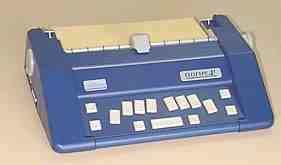
This picture shows the Elotype 4E.
The Elotype 4E is another electronic braille writer produced by Blista Brailletechin Germany. It has the same functions as the Mountbatten Brailler, but it does not have voice output.
Braille Display
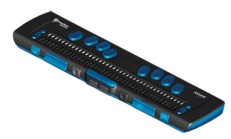
Focus 40 Blue
The picture shows the Focus 40 Blue refreshable braille display by Freedom Scientific. It is a Braille display with 40 cells and an 8-key Perkins-style keyboard. It does not have and a built in word processor you have to connect it to a computer or tablet PC.
Text on a computer can be displayed in braille on a braille display. This is a device that has a row of plastic or metal pins. The pins are controlled by a computer and move up or down to display the characters on a computer screen in braille. A braille display is often called a “refreshable” braille display because it changes when the user moves around the computer screen. The display is normally located under the computer keyboard. You can buy baille displays in various sizes. They are available with 12, 20, 32, 40, 64 or 80 cells. Braille displays with 32 or 40 cells are common in classrooms because the length is convenient for reading and they are not too expensive. A 40-cell braille display can display about half a line of a letter sized document and it costs approximately 3000 Canadian Dollars. Braille notetakers are special braille displays because they can be used even if they are not connected to a computer. They usually have the following features: a built in word processor, calculator, and calendar. Some can access the internet without connecting them to a computer.
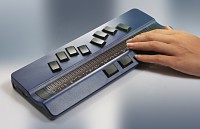
This is the Active Braille a refreshable braille display and notetaker designed by the German company Handytech. It has with a built in word processor, calculator, clock and calendar. You can also type in Music Braille and listen to the notes.
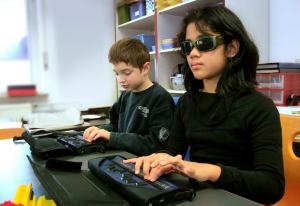
Two students using a braille notetaker.
Computer, Laptops or Tablets
If your student uses a regular refreshable Braille display without note taking capability, it has to be connected to a computer, laptop or tablet computer via USB or Bluetooth to function.
Screen reader
A screen reader is a program that allows blind people to use a computer. Screen readers provide auditory access to information displayed on the computer screen. A screen reader can also display the information on the monitor on a braille display. This program is necessary for connecting a braille display to a computer and is available for PC and Mac. People can use a freeware program such as NVDA (Non Visual Desktop Access) for PC or buy a screen reader such as JAWS (Job Access with Speech) from Freedom Scientific. Apple products already have a built in screen reader called Voiceover as well as a screen magnifier.
Necessary Technology for Producing Material in Braille
Optical Character Recognition Software (OCR) and scanners
In order to produce brailled material from hard-copy documents print material must be scanned and an optical character recognition software used to convert standard print materials to speech or braille.
Print to Braille Software
This software turns regular documents and images into braille documents and tactile graphics which can be read by an embosser and printed out. Common print to Braille programs are: Duxbury, Megadots or RTFC.
Braille Embosser

- The picture shows the Index Basic-D V4 which is produced by Index Braille. This embosser uses fan-folded paper.

- The picture shows the Everest-D V4 which is produced by Index Braille. It uses cut-sheet paper.
A braille embosser prints material in braille and more sophisticated machines can produce braille on both sides of a page. Most embossers can also produce tactile graphics and some can print braille and regular text. Embossers often require special soundproof cabinets because they are quite noisy when in use. They are available in various sizes and embossing speed varies between different models. Some models use cut-sheet paper which is easier and less expensive while others use fan-folded braille paper.
___________________________________________________________________________________
Blista Brailletech. (Photographer). (n.d.). Elotype 4e. [Web Graphic]. Retrieved from http://www.brailletec.de/katalog_elo.htm
Freedom Scientific. (Photographer). (n.d.). Focus 40 blue. [Web Graphic]. Retrieved from •http://www.freedomscientific.com/products/fs/focus-40-blue-new-product-page.asp
Quantum Technology. (Photographer). (n.d.). Mountbatten brailler. [Web Graphic]. Retrieved from http://www.mountbattenbrailler.com/gallery.html







